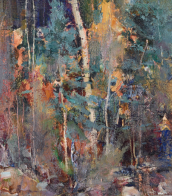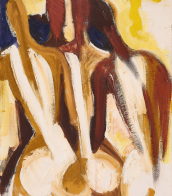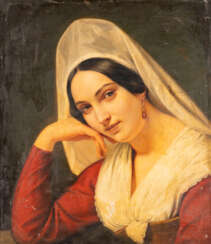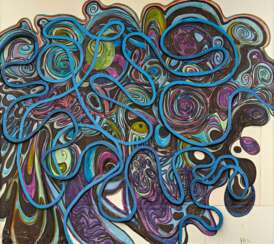hena

Athena Vida, birth name Gitte Schäfer, is a German artist. Working mainly in painting and drawing, her works often explore themes of identity, memory and the human condition.
Vida studied at the Academy of Fine Arts in Stuttgart, Germany. Since then she has exhibited her work in numerous solo and group exhibitions in Germany and abroad.
Her paintings often feature complex, multi-layered compositions in which elements of abstraction and figuration are interwoven. She often incorporates text and symbols into her work, adding an extra layer of meaning.
Vida's drawings are more minimalist, often featuring simple, repetitive shapes and patterns.
Overall, Athena Vida's work is deep and complex, inviting viewers to engage with both the surface images and the deeper layers of meaning lurking beneath them.


Athena Vida, birth name Gitte Schäfer, is a German artist. Working mainly in painting and drawing, her works often explore themes of identity, memory and the human condition.
Vida studied at the Academy of Fine Arts in Stuttgart, Germany. Since then she has exhibited her work in numerous solo and group exhibitions in Germany and abroad.
Her paintings often feature complex, multi-layered compositions in which elements of abstraction and figuration are interwoven. She often incorporates text and symbols into her work, adding an extra layer of meaning.
Vida's drawings are more minimalist, often featuring simple, repetitive shapes and patterns.
Overall, Athena Vida's work is deep and complex, inviting viewers to engage with both the surface images and the deeper layers of meaning lurking beneath them.


Lucas Waghenaer, full name Lucas Janszoon Waghenaer, was a famous Dutch cartographer, navigator, navigator and writer of the Golden Age.
Between 1550 and 1579, Waghenaer sailed the seas as a senior assistant captain and probably socialized with Portuguese, Spanish, and Italian navigators. The knowledge of nautical charts and the instructions Waghenaer received as a result of these contacts had a great influence on his later work as a cartographer. It is evident that the charts he made had to be based on his observations, and in all his work he had to draw on his own extensive experience of practical navigation. His book Spieghel der Zeevaerdt ("The Navigator's Mirror") or Speculum nauticum super navigatione, first published in 1584, occupies a unique place among the nautical printed works of the sixteenth century, for it is the first printed work with maps.
Moreover, in terms of the magnificent design of the maps and text, it surpasses all other editions of this period and served as a model for pilotage guides and folios with maps even a century later. It is an atlas of nautical charts with instructions for navigation in the western and northwestern coastal waters of Europe. Thanks to the unrivaled skill of engravers Baptiste and Johannes van Deitekom, Waghenaer's original maps were transformed into the most beautiful maps of the time. This book was a huge success, reprinted several times and translated into English, German, Latin and French.
In 1592, Waghenaer's second pilot book Thresoor der zeevaert ("Treasure of Navigation") was published, and in 1598, the third and last publication Enchuyser zeecaertboeck ("Enkhuizen Book of Nautical Charts").


Carl Adolf Henning was a German successful portrait painter.


Carl Adolf Henning was a German successful portrait painter.


Karl-Henning Seemann was a German painter and sculptor who lived and worked in Löchgau.
Seemann studied sculpture at the University of Fine and Applied Arts Berlin-Weißensee and the Berlin-Charlottenburg University of Fine Arts. From 1974 to 1999 he served as a professor at the Stuttgart State Academy of Fine Arts and also taught drawing at other institutions.
Seemann is the author of numerous sculptural compositions and fountains in public spaces in German cities. His works attract attention with bright characters of the depicted heroes, created with a share of humor.


Henning Edens was a German landscape painter, greatly influenced by Claude Monet and Camille Pissarro.






Henning Edens was a German landscape painter, greatly influenced by Claude Monet and Camille Pissarro.


Anton Henning is a German self-taught artist, designer, sculptor and installer.
He lives and works in Berlin, London and New York and has established himself as a talented and extraordinary furniture and interior designer. Henning is inspired by views of world capitals while developing his own avant-garde styles. He also wittily analyzes art history through his installations, sculptures and paintings.


Henning Edens was a German landscape painter, greatly influenced by Claude Monet and Camille Pissarro.


Anton Henning is a German self-taught artist, designer, sculptor and installer.
He lives and works in Berlin, London and New York and has established himself as a talented and extraordinary furniture and interior designer. Henning is inspired by views of world capitals while developing his own avant-garde styles. He also wittily analyzes art history through his installations, sculptures and paintings.


Anton Henning is a German self-taught artist, designer, sculptor and installer.
He lives and works in Berlin, London and New York and has established himself as a talented and extraordinary furniture and interior designer. Henning is inspired by views of world capitals while developing his own avant-garde styles. He also wittily analyzes art history through his installations, sculptures and paintings.


Anton Henning is a German self-taught artist, designer, sculptor and installer.
He lives and works in Berlin, London and New York and has established himself as a talented and extraordinary furniture and interior designer. Henning is inspired by views of world capitals while developing his own avant-garde styles. He also wittily analyzes art history through his installations, sculptures and paintings.






Ernest Martin Hennings (Jr.) was an American artist and member of the Taos Society of Artists. In 1901 that Hennings began taking classes at the School of the Art Institute of Chicago, which was largely based on the great European art schools and made particularly emphasis on the importance of drawing. Hennings took up work as a commercial artist, mostly painting murals and portraits around Chicago. Hennings' primary interest was in portrait painting, with his primary subject being the Native Americans living in and around Taos Pueblo. In 1922 he was awarded the Clyde M. Carr Prize from the Art Institute of Chicago as well as the Institute's Fine Arts Building Prize. By the 1920s, the now established painter was building his reputation on the national scene, with exhibitions and awards including. Many art collectors throughout America sought out his paintings. Today paintings by Hennings are housed in the Smithsonian American Art Museum, Stark Museum of Art, Booth Western Art Museum etc.


Anton Henning is a German self-taught artist, designer, sculptor and installer.
He lives and works in Berlin, London and New York and has established himself as a talented and extraordinary furniture and interior designer. Henning is inspired by views of world capitals while developing his own avant-garde styles. He also wittily analyzes art history through his installations, sculptures and paintings.


Anton Henning is a German self-taught artist, designer, sculptor and installer.
He lives and works in Berlin, London and New York and has established himself as a talented and extraordinary furniture and interior designer. Henning is inspired by views of world capitals while developing his own avant-garde styles. He also wittily analyzes art history through his installations, sculptures and paintings.


Anton Henning is a German self-taught artist, designer, sculptor and installer.
He lives and works in Berlin, London and New York and has established himself as a talented and extraordinary furniture and interior designer. Henning is inspired by views of world capitals while developing his own avant-garde styles. He also wittily analyzes art history through his installations, sculptures and paintings.


Anton Henning is a German self-taught artist, designer, sculptor and installer.
He lives and works in Berlin, London and New York and has established himself as a talented and extraordinary furniture and interior designer. Henning is inspired by views of world capitals while developing his own avant-garde styles. He also wittily analyzes art history through his installations, sculptures and paintings.


Anton Henning is a German self-taught artist, designer, sculptor and installer.
He lives and works in Berlin, London and New York and has established himself as a talented and extraordinary furniture and interior designer. Henning is inspired by views of world capitals while developing his own avant-garde styles. He also wittily analyzes art history through his installations, sculptures and paintings.


Anton Henning is a German self-taught artist, designer, sculptor and installer.
He lives and works in Berlin, London and New York and has established himself as a talented and extraordinary furniture and interior designer. Henning is inspired by views of world capitals while developing his own avant-garde styles. He also wittily analyzes art history through his installations, sculptures and paintings.


Anton Henning is a German self-taught artist, designer, sculptor and installer.
He lives and works in Berlin, London and New York and has established himself as a talented and extraordinary furniture and interior designer. Henning is inspired by views of world capitals while developing his own avant-garde styles. He also wittily analyzes art history through his installations, sculptures and paintings.




Ernest Martin Hennings (Jr.) was an American artist and member of the Taos Society of Artists. In 1901 that Hennings began taking classes at the School of the Art Institute of Chicago, which was largely based on the great European art schools and made particularly emphasis on the importance of drawing. Hennings took up work as a commercial artist, mostly painting murals and portraits around Chicago. Hennings' primary interest was in portrait painting, with his primary subject being the Native Americans living in and around Taos Pueblo. In 1922 he was awarded the Clyde M. Carr Prize from the Art Institute of Chicago as well as the Institute's Fine Arts Building Prize. By the 1920s, the now established painter was building his reputation on the national scene, with exhibitions and awards including. Many art collectors throughout America sought out his paintings. Today paintings by Hennings are housed in the Smithsonian American Art Museum, Stark Museum of Art, Booth Western Art Museum etc.

































































